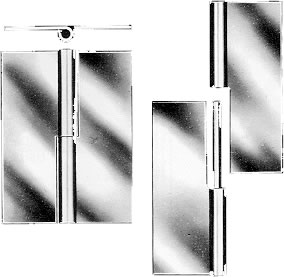
When shopping for hinges, you may come across take-apart hinges. They look like most other hinges. Take-apart hinges still feature two leafs, which allow for a limited degree of rotation once installed. Take-apart hinges, however, can be easily removed. What are take-apart hinges, and how do they differ from traditional hinges?
What Is a Traditional Hinge?
A traditional hinge is a bearing that connects two objects. Hinges are commonly used on doors and gates. Most doors and gates feature a set of hinges.
Traditional hinges simply feature a traditional design consisting of two rectangular-shaped leafs and a pin. The two leafs are pressed together at the knuckle. A rod-shaped pin is then placed through the knuckle. With the pin in place, the leafs will remain interconnected.
What Is a Take-Apart Hinge?
A take-apart hinge is a special type of hinge that can be removed via lifting. Also known as a loose-joint hinge, it still features two leafs and a pin. Take-apart hinges are also used for the same purpose of connecting two objects, such as doors and gates.
Take-apart hinges feature a removable, lift-off design. You can remove them from the objects to which they are connected by lifting them. More specifically, lifting the object — the door or gate — will result in one of the leafs separating from the other leaf.
Differences Between Traditional and Take-Apart Hinges
Traditional hinges and take-apart hinges aren’t the same. Only take-apart hinges can be removed via lifting. You can’t just lift a traditional hinge to remove it. Instead, you’ll need to either knock out the pin using a tool or remove the fasteners holding the traditional hinge in place. Take-apart hinges offer an easier solution.
Take-apart hinges make it easy to remove doors and gates. You can lift the door or gate to remove it. Lifting the door or gate will then separate the take-apart hinge’s leafs. One of the leafs will remain on the door or gate, and the other leaf will remain on the adjacent frame or fence.
How Take-Apart Hinges Work
Take-apart hinges use a straightforward method of operation. The two leaves have a knuckle along their length. The knuckle on one leaf matches the knuckle on the other leaf, allowing the central pin to pass through and connect the two leaves together.
The pin, however, will remain connected to one of the leafs at all times. When you lift the door or gate, the top leaf will separate from the bottom leaf. You won’t need to knock out the pin, nor will you need to remove the take-apart hinge.
